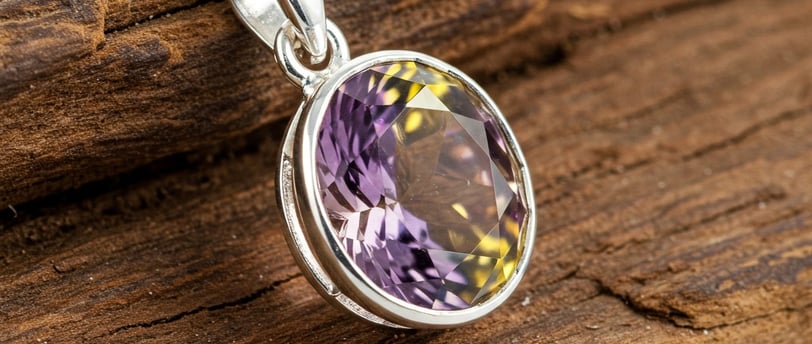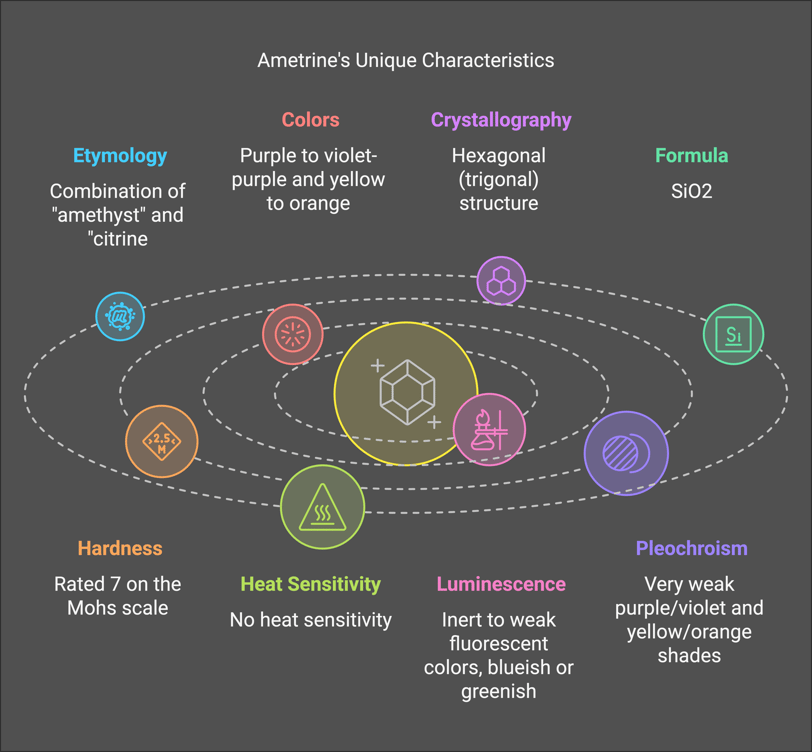Ametrine
Discover the beauty of ametrine, a gemstone with a fascinating history and vibrant colour zoning that makes it a sought-after choice for jewellery.
1/30/20252 min read


History
Ametrine, a captivating gemstone, is a variety of quartz that uniquely displays both amethyst (purple) and citrine (yellow to orange) colours in a single gem. This natural wonder is also known as amethyst-citrine. The presence of both colours in one crystal is considered a rare gift of nature. The gemstone was introduced outside of Bolivia in the 17th century when a Spanish conquistador received it as a dowry for his marriage to an Ayoreos princess. However, the mine was seemingly lost to commercial interests until the 1960s. Ametrine’s bicolour appearance quickly became popular with dealers and gem designers.
Mineral Origins
The only commercial source for ametrine is the Anahi mine in Bolivia. Although there have been small, non-commercial deposits found in other locations like Brazil, the United States, Canada, India and Mozambique, Bolivia remains the primary source of gem-quality material. The unique colour zoning in ametrine is due to fluctuations in temperature and pressure during its formation, leading to iron impurities that cause the purple (amethyst) or yellow/orange (citrine) zones within a single quartz stone. This is why it is known as a bicolour gem.
The 4 C's
Colour
Fine ametrines show a beautiful contrast between their orange and purple shades. The most prized ametrines have medium dark to moderately strong orange and vivid to strong purple or violetish-purple. Dealers often look for a half-and-half distribution of each colour with a sharp boundary between them, typically at the centre of the gemstone. Some cuts blend the colours, creating shades of rosy gold, mauve, champagne or peach.
Clarity
Most gem-quality ametrines do not have eye-visible inclusions. This means that the majority of faceted ametrines available on the market appear "eye-clean".
Carat
Ametrine is available in a wide range of sizes. Generally, larger gems tend to display the most intense colours. Large material is also popular with gem carvers. The price per carat does not usually increase with larger sizes since ametrine, like most quartz gems, is found in fairly large, clean pieces.
Cut
Cutters enjoy finding ways to maximise the beauty of ametrine. The most popular cuts are those that highlight the unique colour combination. Emerald cuts and other shapes with a 50/50 colour split have been popular, but some cutters now use designs that blend the yellow and purple to create new shades. Connoisseurs often appreciate imaginative designer cuts that display ametrine’s two colours in artfully blended or contrasting combinations.
Be Aware Of
Enhancements
Ametrine is rarely treated but may have filled fractures.
Simulants
Any gem can be imitated, sometimes with man-made or natural materials chosen to impersonate a particular gem.
Synthetics
Synthetic counterparts of ametrine exist that have the same chemical, physical and optical properties but are created in a lab. Gemological testing is necessary to distinguish synthetic from natural ametrine as synthetic quartz can now duplicate twinning, which was once an indicator of natural origin.
Final Thoughts
Buying Tips
When buying ametrine, focus on the depth and vividness of the colours and the distinction between the colour zones. The artistry of the cut or carving can add value. There are no standardised quality-grading scales, so trust your eye when picking out an attractive stone.
Jewellery Care
Ametrine is relatively durable, with a hardness of 7 on the Mohs scale, making it suitable for everyday wear. It is not sensitive to temperature changes or household chemicals. Warm, soapy water is a safe way to clean ametrine. Over time, rings might need repolishing.


Gemius Stones
Expertise
© 2025. All rights reserved.
